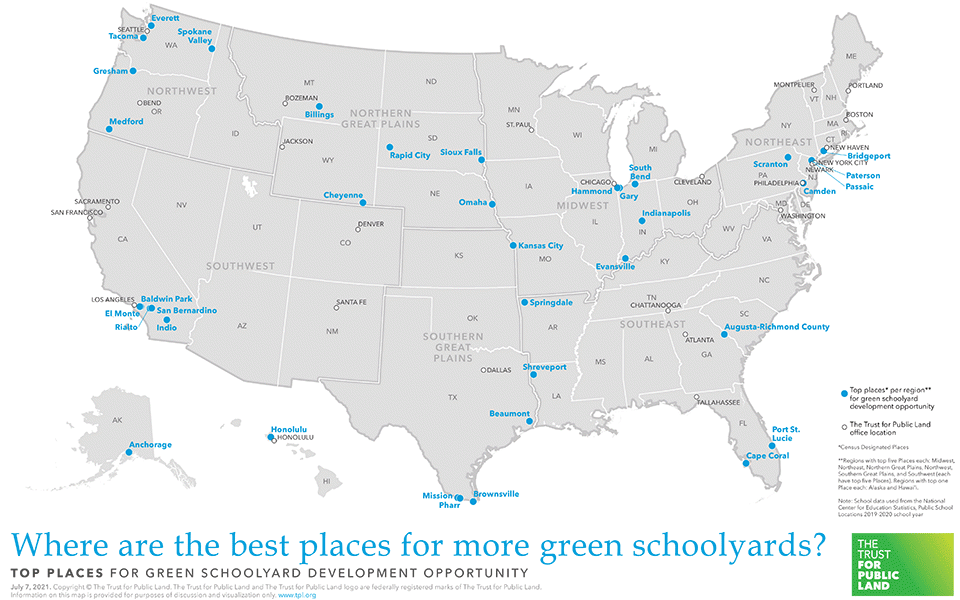A global pandemic. Rising heat. Learning loss. Teenage depression. Obesity. Systemic racism and unequal access to the outdoors. The United States is faced with a plethora of health, social, and environmental problems, ranging from challenges to crises. With a new school year getting underway, educators, policy experts, and families are trying to figure out how to bring American schoolchildren back to the classroom in a way that is safe and equitable.
One of best strategies for doing so is looking beyond the classroom—to the schoolyard. Of the 90,000 public schools in the country, only a tiny fraction have schoolyards that are green and inviting, as well as open to the public after school and on weekends. Most are overheated, vacant, and uninspired. The Trust for Public Land believes that transforming America’s schoolyards into shared public parks by 2030 is a common-sense, cost-effective solution to America’s park equity problem. Opening all public schoolyards during non-school hours would put a park within a 10-minute walk of nearly 20 million people—solving the problem of outdoor access for one-fifth of the nation’s 100 million people who don’t currently have a park close to home.
[We’re bringing more parks to communities across the country. Sign up for the latest news about this important work.]
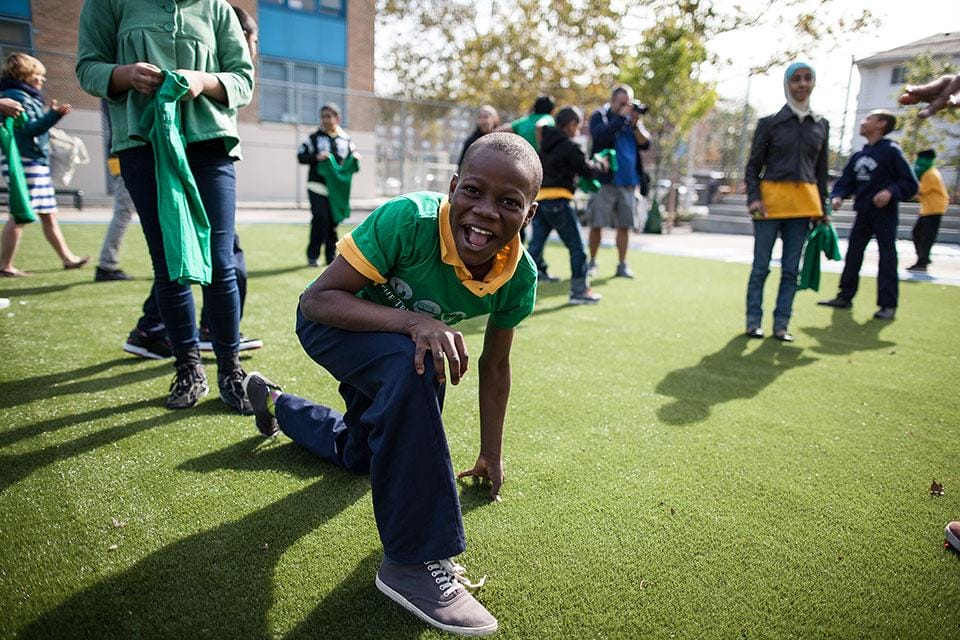
Across the 100 largest cities in America, predominantly white neighborhoods average more park acreage per person than neighborhoods that are home primarily to residents of color, according to new research from The Trust for Public Land.
- Swapping out blacktop for trees, gardens, and up-to-date play equipment would deliver a raft of benefits to students, from emotional to academic, studies show. Teachers and school administrators report that attendance, behavior, and test scores improve following schoolyard renovations.
- A recent study by The Trust for Public Land found that nationwide, 36 percent of the nation’s 50.8 million public school students attended school in a heat island, which is defined as 1.25 degrees Fahrenheit warmer or more, on average, than the surrounding town or city. Among that group, 4.1 million students went to a school in a severe heat island of 7 degrees or more, while 1.1 million attend school in an extreme heat island of 10 degrees or more. In some communities, the heat anomaly exceeded 20 degrees.
- Our analysis showed significant differences in household income between neighborhoods surrounding the hottest schools and those in the coolest parts of town. In areas with the most extreme heat (5 or more degrees hotter than the citywide average), household income averages $59,000. By contrast, in the coolest parts of town, where temperatures were slightly below the citywide average, we found an average household income of $91,000. A similar pattern holds for schools serving students of color.
- Using metrics like heat, water quality, physical activity, and mental health, The Trust for Public Land has identified 45 large school districts in nine regions of the United States that most urgently need the Community Schoolyards model.
- Community Schoolyards projects have the potential to help shrink the park equity divide. In the 100 largest U.S. cities, neighborhoods where residents predominantly identify as people of color have access to an average of 44 percent less park acreage than predominantly white neighborhoods, data analysis by The Trust for Public Land has found. A similar pattern emerges in low-income versus high-income communities.
- Renovated schoolyards have climate superpowers as well. Specially landscaped gardens, bioswales, and porous surfaces absorb stormwater, thereby preventing floods, while trees cool down play spaces.
 The schoolyard solution
The schoolyard solution
As families across America prepare to return to school in person this month, teachers are tweaking class lists, principals are ordering smart boards, and custodians are waxing floors. But there is one area of the school campus that is often overlooked but has the potential to benefit students as much as, if not more than, the latest technology or curriculum trend: the schoolyard.
[How well is your city meeting the need for parks? Explore the 2021 ParkScore rankings.]
America’s typical public schoolyard—a sea of asphalt, perhaps with a few cracks sprouting weeds—actually harms the nation’s schoolchildren. Schoolyards bake under the hot sun. They flood during downpours. With little to no play equipment, they inspire (at best) hanging out and (at worst) fighting and bullying, rather than active, creative play. Lacking gardens and outdoor classroom space, they fail to provide teachers with a place to engage students in hands-on lessons relating to, say, plant science, or venues for older students to learn about green jobs, from climate science to landscape architecture. Of the 90,000 public schoolyards in the United States, less than one percent of them are rich in green space and stay open to the neighborhood outside of school hours.

Before & After: Converting asphalt schoolyards into colorful spaces teeming with trees, gardens, artwork, and play features yields all kinds of benefits for students and the wider community, centering on health, education, climate, and park access.
It is usually students in low-income, racially diverse urban neighborhoods who suffer the worst inequities when it comes to the quality of their schoolyards. What’s more, students living in disadvantaged neighborhoods enjoy far less park space in general than those in well-off communities. According to research from The Trust for Public Land, in the 100 largest U.S. cities, neighborhoods where residents predominantly identify as people of color have access to an average of 44 percent less park acreage than predominantly white neighborhoods, and the same pattern holds for low-income neighborhoods compared to high-income neighborhoods.
Renovated schoolyards can also serve as vital green space for the entire community. Growing numbers of districts are allowing local residents to use their school grounds after school and on weekends, giving not only students but people of all ages new access to parkland. Across the United States, public schools occupy about two million acres of land. By making schoolyards available to the public during nonschool hours, districts could unlock park access for nearly 20 million people, including 5.2 million children.
Decades of research have demonstrated myriad ways that a lack of access to nature has cost people their health, happiness, and prosperity for generations. Communities with less park space are hotter in summer, have worse air quality, and are more susceptible to catastrophic flooding. People without parks close to home get less exercise. Lack of access to parks is associated with higher rates of heart disease, stroke, and obesity.
The good news is that a solution to all of these problems is readily available. In the past two decades, The Trust for Public Land has worked with more than 280 schools across the country, from New York City to Dallas to Tacoma, Washington, turning grim blacktop “playgrounds” into vibrant, verdant spaces that do double duty as neighborhood parks outside of school hours. These Community Schoolyards projects are improving the health, equity, and climate resilience of neighborhoods across the country and transforming the lives of students, families, teachers, and the whole community.

In Newark, New Jersey, The Trust for Public Land helped renovate the schoolyard at the K–8 Sussex Avenue School in 2015. Darleen Gearhart, the former principal who is now director of mathematics for the Newark Board of Education, called the “before” version of the schoolyard “the worst surface ever.” “It was basically a blacktop,” she explained. “It had one basketball hoop, which wasn’t even in good shape, and it was all asphalt with a dumpster in the back. [The blacktop] was emitting heat, and if you fell down, you’d hurt yourself.”
As with all of The Trust for Public Land’s Community Schoolyards projects, students themselves helped design the new space. All of the grades voted on features they wanted in the new schoolyard, and the third and fourth graders worked closely with landscape architects on the design. In addition to a turf field and running track, the half-acre schoolyard now teems with trees and flowering shrubs. There is a drinking fountain for the first time and a seating area, fashioned from large blocks of granite, that functions as an outdoor classroom.
Gearhart was thrilled to watch the schoolyard’s physical transformation from asphalt expanse to welcoming green park—but she says that some of the project’s most important benefits were harder to see. Average daily attendance at Sussex Avenue School climbed from 90 percent to 96 percent almost immediately after the renovation. Disciplinary actions declined, while test scores went up among the school’s 500 students, 95 percent of whom qualify for a free or reduced lunch.
“We were one of the worst schools in the district, and during the eight years I was there, we became one of the best,” she said. The State even moved Sussex Avenue off its list of at-risk schools—a change Gearhart attributes in part to the Community Schoolyards project. “It had an emotional impact on the kids and made students feel safe,” she added. “When you create an environment where they can fall down on the turf and bounce back, it makes you feel like somebody has your back. It changes your life. To a large degree, the new schoolyard changed a lot of lives.”
A resource for hard-to-reach students
The story of renewal at Sussex Avenue School has played out in communities across the country. In New York City, where The Trust for Public Land has overhauled more than 215 schoolyards, tens of thousands of students have benefited from both the design process and the result.
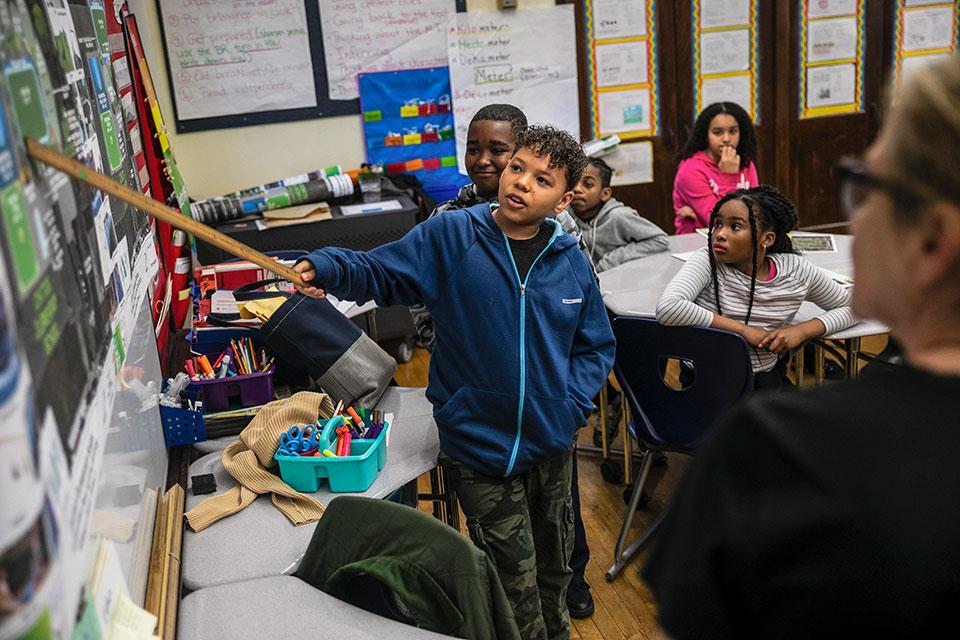
Students are involved in all stages of Community Schoolyards projects, from brainstorming about the design to stewarding the trees and gardens.
Principals and teachers say that involving students in the design is empowering, giving them a sense of their own agency. The resulting schoolyards—with garden beds and outdoor classrooms—are also crucial resources for students who might not thrive in a traditional class setting.
At Stephen A. Halsey Junior High School in Queens, Chris Weiss said the new schoolyard sparked positive changes in hard-to-reach students. Weiss, a veteran teacher of 26 years, coordinates the school’s Green Team, a sustainability club that tends the garden beds and trees on the schoolyard. He also oversees a special room where students who are having emotional crises, fighting, or otherwise disrupting the classroom can go take a break for a few hours (or a few days).
Weiss decided to recruit these students for the Green Team. The turnaround was, and continues to be, astonishing. “They stopped getting sent down to me,” he said. “Their grades got better. They took more pride in what was going on. It wasn’t just about pen and paper, or now computer and screen; they were able to get their hands dirty.” From a first-year group of six or seven students, the Green Team soon grew to over 40.
Weiss says something profound arises from taking care of plants and trees. “If there has been a dry spell, I’ll send the kids out there with watering cans,” Weiss says. “They understand that they are caretakers and stewards of something that is living. It’s meaningful.”
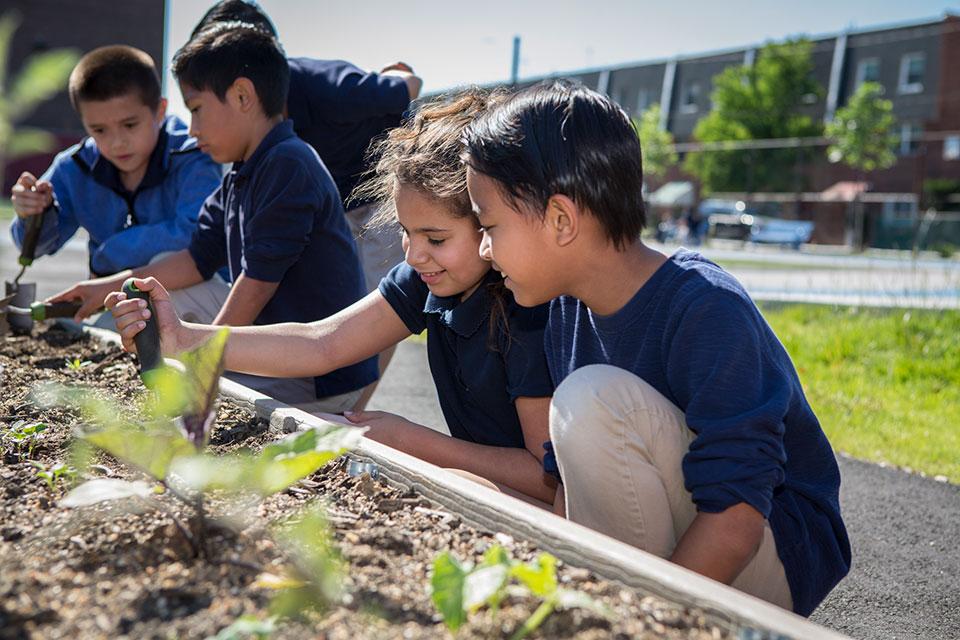
The Community Schoolyards model gives students a range of spaces to explore. There are hands-on garden beds; places for active recreation, like basketball courts and climbing structures; and quiet areas for reading and socializing.
The Trust for Public Land’s work on schoolyards in New York City was recognized this spring by the American Society of Landscape Architects, which awarded the program its Olmsted Medal. “A hallmark to this initiative has been TPL’s commitment to ‘green’ practices, designed to conserve natural resources and increase resiliency, reduce flooding, improve the environment, and address climate change,” the society’s citation said. “Throughout the planning phase of each school’s playground redesign, the students themselves have had a ‘seat at the table,’ empowering them to voice their opinions and take ownership of the building of each playground.”
[Learn more: America’s schoolyards are packed with potential. Help us unlock it.]
The benefits of Community Schoolyards projects have yet to be studied in a systematic, rigorous way that measures potential improvements in everything from attendance to test scores following a schoolyard renovation. But anecdotally, we know that the increase in positive attributes and the decline in negative ones—fights, for example—are strongly correlated with the revamping of asphalt schoolyards into green spaces.
For example, several years ago at John M. Patterson School in Philadelphia, the principal, Kenneth Jessup, was so fed up with the fighting during recess that he was thinking of taking an early retirement. But after renovation of the schoolyard at the elementary school, suspensions went from 30 a year to zero; Jessup attributes the plummeting disciplinary actions to the new outdoor space. “The students actually have something to do now during recess, whereas before it was just an empty space with chunks of loose concrete,” he said.
Community Schoolyards™ projects for climate justice

With trees and shade structures, the Community Schoolyards approach can counter the urban heat island effect, in which city neighborhoods dominated by pavement, concrete, and brick heat up faster than their suburban and rural counterparts.
Of course, Community Schoolyards projects are not a panacea for decades of underinvestment or systemic racism in public schools and neighborhoods. But for a space that measures just a half acre to a few acres, a renovated schoolyard packs a lot of punch.
A growing body of evidence points to the relationship between access to green space and improved educational outcomes. By virtue of their trees and cooling shade, Community Schoolyards projects could help students improve their test scores. One study out of New York City, for instance, found a correlation between rising temperatures and falling test scores. A 2018 study by the Harvard Kennedy School, the College Board, and others provided evidence that cumulative heat hurts cognitive development. The analysis of 10 million students who took the PSAT, a preliminary college entrance exam, showed that “hotter school days in the year prior to the test reduced learning, with extreme heat being particularly damaging . . . for low income and minority students.”
Ample research, too, illustrates improvements in mental and physical health, as well as concentration and stress levels, when young people live near parkland. Some studies suggest that students are less anxious and more focused when they can see greenery from their classroom windows.
A landmark study last year in the journal Climate found that urban neighborhoods with hotter temperatures were also the ones that experienced redlining in the 1930s, when the Federal Home Owners’ Loan Corporation drew a red line around majority Black communities and advised banks not to lend to would-be buyers in these neighborhoods. The analysis of 108 formerly redlined urban communities across the United States revealed that more than 90 percent were warmer than neighborhoods in the same city that had not been subject to the discriminatory practice. The temperature difference ranged up to 13 degrees.
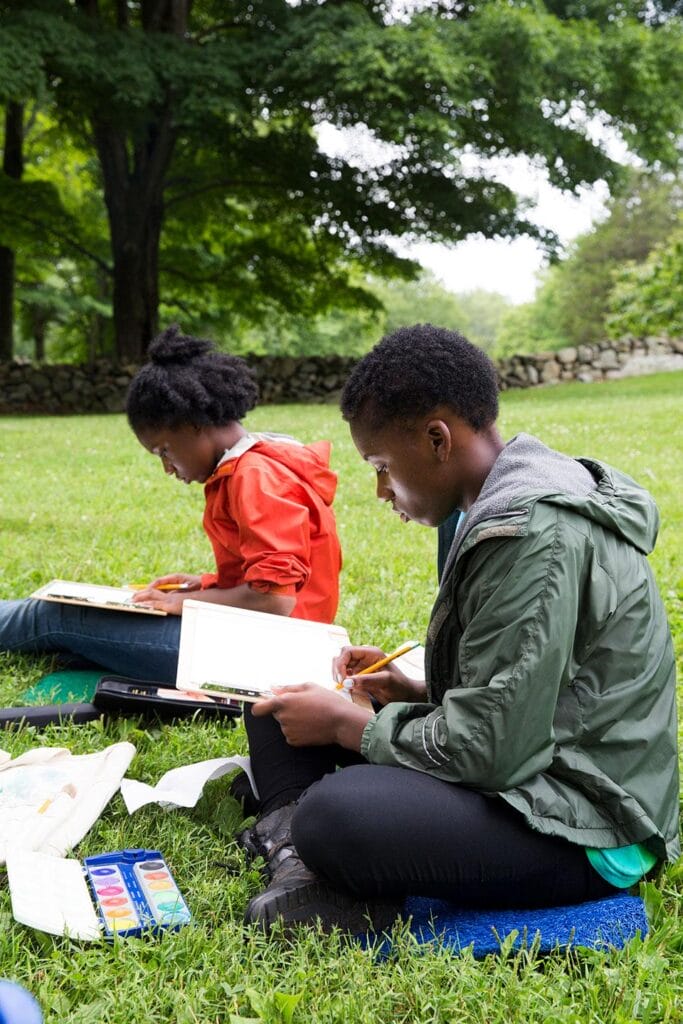
Children are more susceptible to heat-related illness than adults since their bodies cannot regulate temperature as efficiently. Swapping blacktop for trees and shrubs creates cooling shade that lowers the temperature on schoolyards.
Cities are already hotter than surrounding suburbs and rural areas, a phenomenon known as the urban heat island effect. That occurs when landscapes dominated by asphalt and concrete absorb heat faster and hold on to it longer than green landscapes. Even within cities, heat islands vary widely, with low-income neighborhoods more susceptible to heat than affluent ones.
Homeownership is the main instrument for accumulating wealth in American society, experts say. Depriving people of that ability through redlining, coupled with decades of institutional racism, has had a cascading effect on communities of color. Entrenched poverty has meant a lack of political clout, which in turn has made it difficult for residents to advocate successfully for better schools and new parks. The result is a paucity of parkland, as well as cooling vegetation like grass and trees found in private yards. Students attending schools trapped in the middle of these heat islands are at a disadvantage, compared to their counterparts across town.
The Union of Concerned Scientists projects that temperatures will climb to frightening levels through this century, putting more and more students at risk of heat stress and jeopardizing their educational well-being. The group’s 2019 report, Killer Heat in the United States: Climate Choices and the Future of Dangerously Hot Days, found that, absent action to cut greenhouse gases, by mid-century the average number of days per year with a heat index above 100 degrees (F) will more than double compared to average conditions from 1971 to 2000.14 Similarly, the days above 105 will quadruple.
Children are especially vulnerable to heat stress, health experts say. According to the American Academy of Pediatrics, children are less able to regulate body temperature than adults15. Extreme heat can trigger a number of adverse effects in children, most commonly dehydration. High temperatures can also lead to heat exhaustion, heat cramps, and heat stroke.
New insights on longstanding schoolyard disparities
Equipping the nation’s schoolyards with infrastructure to counter these worrisome trends is therefore paramount. Vegetation and tree canopy lower temperatures on schoolyards through direct shade and a process known as evapotranspiration, a mechanism in which moisture is released by leaves. An area of shade can be as much as 50 degrees cooler than a similar patch in full sun.
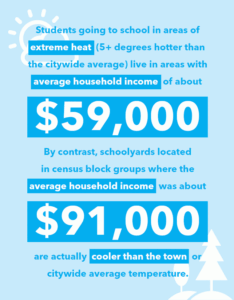 But new data from The Trust for Public Land underscores a disheartening reality. Schools that skew lower-income or serve primarily Black and Hispanic students are hotter than those that are whiter and wealthier. The finding echoes the study in Climate about historically redlined areas. Our analysis showed significant differences in household income between neighborhoods surrounding the hottest schools and those in the coolest parts of town. In areas with the most extreme heat (5 or more degrees hotter than the citywide average), household income averages $59,000. By contrast, in the coolest parts of town, where temperatures were slightly below the citywide average, we found an average household income of $91,000.
But new data from The Trust for Public Land underscores a disheartening reality. Schools that skew lower-income or serve primarily Black and Hispanic students are hotter than those that are whiter and wealthier. The finding echoes the study in Climate about historically redlined areas. Our analysis showed significant differences in household income between neighborhoods surrounding the hottest schools and those in the coolest parts of town. In areas with the most extreme heat (5 or more degrees hotter than the citywide average), household income averages $59,000. By contrast, in the coolest parts of town, where temperatures were slightly below the citywide average, we found an average household income of $91,000.
A similar pattern holds for schools serving students of color. Our data scientists looked at schools whose percentage of students of color ranged from very low to very high. The schools with the most students of color were a full degree hotter than the local average temperature in the surrounding community, while those with the most white students were a third of a degree cooler than the local average.
In another study, The Trust for Public Land found that nationwide, 36 percent of the nation’s 50.8 million public school students attended school in a heat island, which is defined as 1.25 degrees Fahrenheit or more, on average, than the surrounding town or city. Among that group, 4.1 million students went to a school in a severe heat island of 7 degrees or more, while 1.1 million attend school in an extreme heat island of 10 degrees or more. At some schools, the heat anomaly—the difference in average temperature between the average temperature on the schoolyard and the citywide average temperature—exceeded 20 degrees.
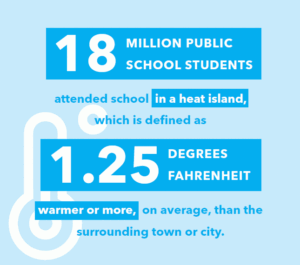 Addressing the inequities between affluent communities and those that have been marginalized will require concentrated effort, prioritizing school districts according to need. The Trust for Public Land has combed through tens of thousands of districts from Nevada to New Jersey, using metrics of water quality, urban heat, physical activity levels, mental health, and vulnerable populations, and compiled a list of school districts in each of nine regions that stand to benefit the most from the Community Schoolyards model.
Addressing the inequities between affluent communities and those that have been marginalized will require concentrated effort, prioritizing school districts according to need. The Trust for Public Land has combed through tens of thousands of districts from Nevada to New Jersey, using metrics of water quality, urban heat, physical activity levels, mental health, and vulnerable populations, and compiled a list of school districts in each of nine regions that stand to benefit the most from the Community Schoolyards model.
Focusing on school districts with at least 10,000 students, we determined that in the Northern Great Plains, for instance, cities like Billings, Montana; Cheyenne, Wyoming; Omaha, Nebraska; and Rapid City and Sioux Falls, South Dakota, would gain the most from schoolyard renovations. In the Southeast, Port St. Lucie and Cape Coral, Florida, as well as Augusta-Richmond County in Georgia, are among the best candidates for a schoolyards initiative.
Reducing flood risk and boosting climate resilience
Renovating schoolyards with the aim of creating healthy learning environments has the added benefit of building in climate resilience. Under most future scenarios, climate change will result in more weather extremes, including intense rain storms that cause flooding. In addition to lowering the heat, shrinking the asphalt footprint of schoolyards by planting trees and gardens can mitigate local flooding.
In older cities with combined sewer and stormwater systems, even a moderate rainfall can overwhelm wastewater treatment plants. The result is that untreated sewage, together with stormwater, flows directly into nearby rivers and bays.
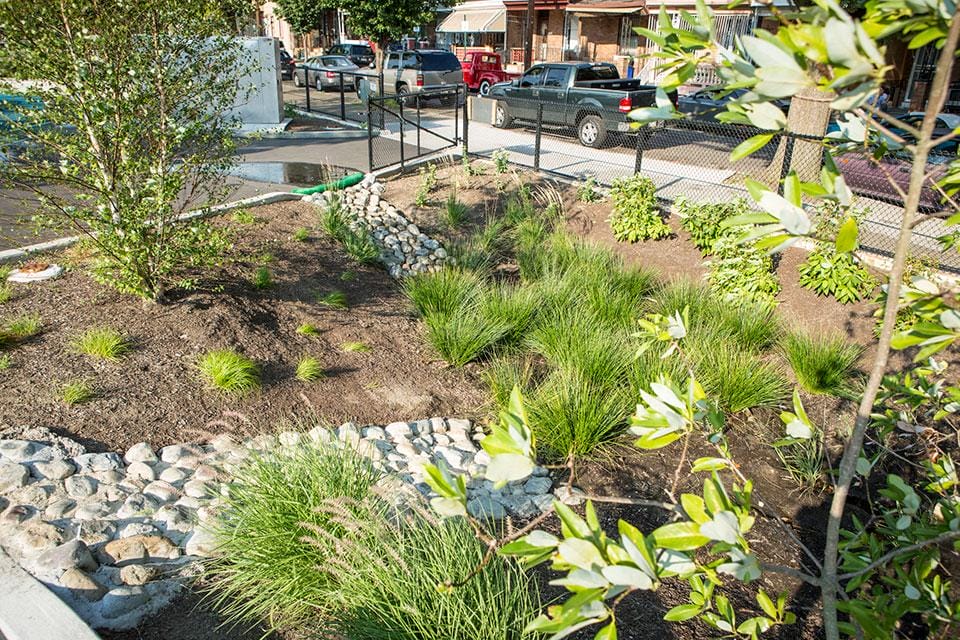
Green infrastructure like trees, rain gardens, and bioswales prevents flooding on schoolyards, making them available for play throughout the year. Those features also capture stormwater during rain events, improving water quality in local rivers.
Many cities are trying to address the problem by installing a combination of so-called gray infrastructure like pipes and holding tanks, and green infrastructure like bioswales (heavily planted depressions in the soil). Community Schoolyards projects similarly deploy a number of water-capture strategies, from engineered soils beneath turf fields to roomy tree pits to rain gardens. In New York City, our Community Schoolyards spaces capture an estimated 19 million gallons of stormwater a year, helping to prevent combined sewer overflows. And in Philadelphia, our renovated schoolyards capture 17 million gallons of stormwater annually.
Installing green infrastructure at public schools reduces flood risk throughout the neighborhood, protecting people, homes, businesses, and the environment. But it also provides direct benefits to students whose schoolyards are subject to flooding. In Tacoma, Washington, Abby Sloan, principal of Jennie Reed Elementary School, says the community surrounding the school has the least amount of green space in all of Washington State. The school does have a big green field that students love—at least for the six weeks a year when it’s not under water or prohibitively muddy. “About one-third of the field is under water from November to early April,” she lamented. “We call it Lake Reed.”
Jennie Reed is one of two Tacoma schoolyards that The Trust for Public Land is helping to renovate, and three more are set to begin next year. The planned green infrastructure at Jennie Reed—trees, rain gardens, and bioswales—should prevent flooding. Importantly, the soft, natural surfaces will greatly improve acoustic conditions on the school grounds. Interstate 5 runs right next to the school property, and when the field is unusable, students are confined to an elevated strip of blacktop next to the school building, making the sound barrier along the interstate less effective. “We can hardly hear ourselves speak,” Sloan says. “It’s such a sensory overload.” When the rebuild is complete and the field is available throughout the year, students will have a quieter, calmer environment at school.
In Los Angeles, where The Trust for Public Land is proposing 28 green schoolyards projects in time for the Olympics in 2028, the landscape design must be adapted to extremes of weather. Trust for Public Land Los Angeles Program Manager Robin Mark said schoolyards feature not only drought-tolerant grasses and shrubs, but bioswales that capture floodwater.
“We don’t get regular rain, but when we do get it, we get a ton of it,” Mark says. “The amount of water flowing off existing schoolyards, which are impermeable, is a huge source of runoff. It ends up in the ocean as dirty water.”
Nearly 400 miles north in Oakland, we have worked to transform the schoolyard at International Community School, where 90 percent of students qualify for a free or reduced lunch, as well as a handful of other schoolyards in the city. “The living schoolyard project started five years ago, and we felt the best way to close the opportunity gap for students is to provide outdoor space where learning can happen,” said Eleanor Alderman, the school principal, adding that students could “feel and touch and investigate and do inquiry in a really hands-on way.”
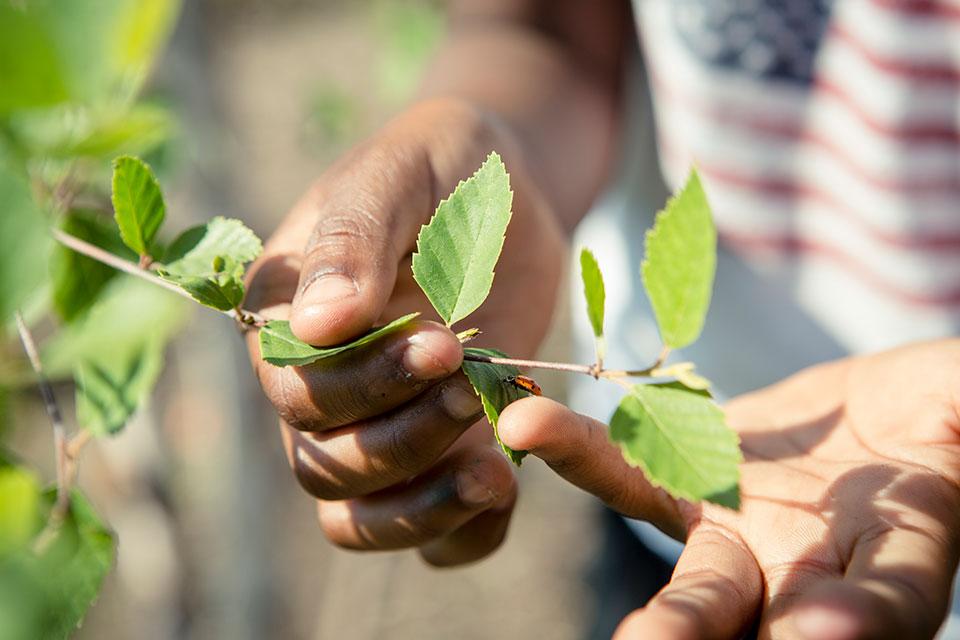
Vegetation in Community Schoolyards projects can serve as a visual buffer against the cars and trucks on nearby streets or highways, while also helping to mitigate traffic noise.
Equipping the next generation of environmental leaders
In the process of designing their schoolyards, students learn important lessons, not only about water systems, but climate change and environmental justice. In Atlanta, Summer M. Blackmon, a teacher and STEM specialist at Centennial Academy, recently worked with The Trust for Public Land on a series of workshops for the fifth and sixth graders.
Because the schoolyard will be open to the community when school is not in session, students in one workshop were asked to consider what their relatives and neighbors might desire in a green space. They set off to find out, conducting interviews and then producing short videos. A second workshop focused on environmental justice. Students, or “scholars” as Blackmon calls them, were shown a large map of Atlanta that identified parks and lakes, as well as factories and landfills, within different zip codes.
“They were able to see that there are strong discrepancies in certain pockets of our city, with lots of parks in some areas and few parks in other areas,” Blackmon said. “The students noticed that there was not a lot of green space where they live. Some of our scholars verbalized that it wasn’t fair.”
Students at the charter school near downtown Atlanta will soon have an opportunity to move the needle on park equity through their Community Schoolyard, one of several The Trust for Public Land is pursuing in the city. During the pandemic, the fifth and sixth graders participated remotely in a budgeting and brainstorming exercise. Working individually, the students were alloted virtual money and asked to decide what to purchase for the new schoolyard—anything from play equipment and recycling bins to benches to water fountains. Trees were free.
The Trust for Public Land staff created a special catalogue in which the prices were commensurate with the students’ budgets. In general, the students prioritized grass and trees over swings and slides. “We wanted them to think of themselves as activists now that they had learned about some of the environmental injustices,” Blackmon said. “They wanted natural areas so that kids had room to walk and run. They talked about the trees in terms of providing shade since it’s very hot in Atlanta.”
The campaign to green the nation’s schoolyards is part of a larger movement centered on outdoor education. In Scandinavia, many preschools conduct classes entirely outside in the belief that exposure to nature and the elements fosters social skills and emotional resilience. Even older students are often outside, says Thomas Hatch, a professor of education at Teachers College of Columbia University and the director of the National Center for Restructuring Education, Schools & Teaching.
For a sabbatical he took several years ago, Professor Hatch moved his young family to Norway for a year. Two of his school-aged daughters spent significantly more time outdoors during the school day than they had in their hometown of Hastings-on-Hudson, New York. His younger daughter, for example, spent an hour outside every day. His oldest went cross-country skiing with her class for one full day a week during four weeks of the winter.
“This approach to outdoor education falls within a much larger cultural context in which being outside and learning how to ski, for example, are seen as important for overall development,” said Dr. Hatch, coauthor of the new book The Education We Need for a Future We Can’t Predict. “The elementary school is designed in a way that it doesn’t get in the way of that.”
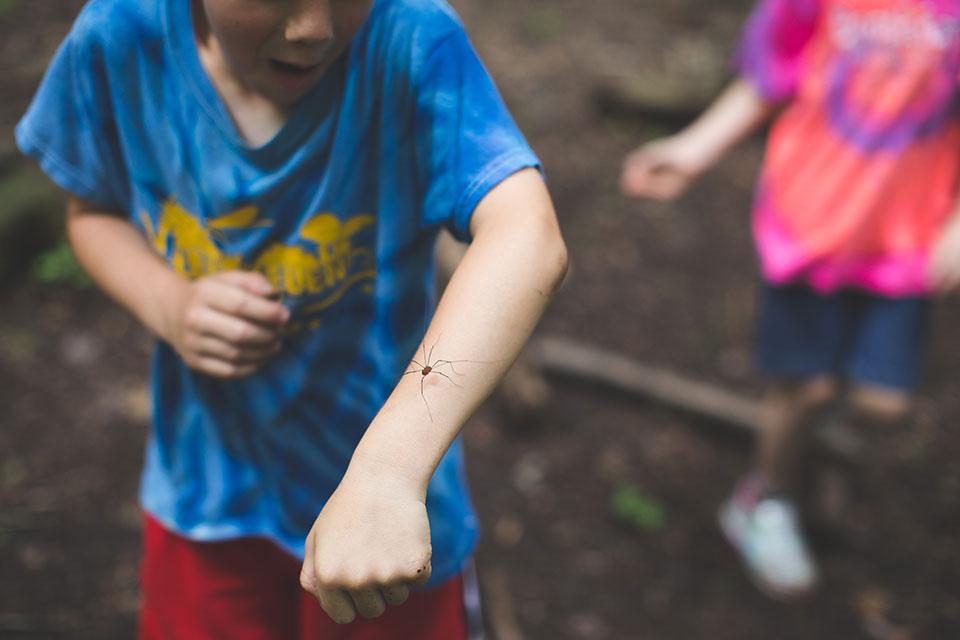
The Community Schoolyards model, which encourages nature play and hands-on learning, dovetails with an outdoor education movement that has spread from Scandinavia to the United States.
The outdoor learning movement is gaining momentum in the United States as well, particularly among preschool children. Each of our Community Schoolyards includes an outdoor classroom, usually a separate area with rustic seating for students arranged in a semicircle. The Trust for Public Land has partnered with the Children & Nature Network, a nonprofit that promotes equitable access to nature, on schoolyard initiatives around the country. Last fall, the two organizations launched the Green Schoolyards Peer Learning Network, a group of school, government, and nonprofit representatives from around the country who regularly join together online to discuss strategies.
“It’s a way to find out how people are tackling similar problems,” explained Jaime Zaplatosch, vice president of Green Schoolyards for Healthy Communities at Children & Nature Network, referring to the peer-learning workshops. “It helps fuel the movement and scale up across the United States in a way that we just couldn’t do otherwise.”
In addition to boosting the well-being of students during the school day, parents say the renovation of their children’s schoolyards greatly improved family life by providing additional nearby park space. Denis Devine and his wife, Kate Hughes, joined forces with The Trust for Public Land to transform their children’s schoolyard at Alexander Adaire Elementary School in the Fishtown neighborhood of Philadelphia. “The schoolyard used to be asphalt with a dumpster, which was the only object,” Devine said. “So the kids were playing tag around parked cars and a smelly dumpster.”
After the renovation was finished in 2017, the culture of the school changed dramatically. Today, his boys—Bennett, a rising third grader, and Finn, a rising fourth grader—go out during recess to find a rain garden that attracts butterflies, trees, basketball hoops, play equipment, and an outdoor classroom. “The kids love digging in the rain garden,” Devine said “There are students whose love for science and nature is cultivated in that schoolyard. And a lot of them want to stay after dismissal and go back on weekends. Before the renovation, the schoolyard immediately emptied out.”
Healthy students, healthy communities

Once a Community Schoolyards project is complete, the school district agrees to open the schoolyard to the community after school and on weekends.
One motivator behind the outdoor education movement is health. Exposure to nature has been shown in multiple studies to yield all sorts of health benefits. And students don’t need to break a sweat to reap them. Indeed, access to green space and time spent in nature are associated with a number of positive outcomes: reduced stress, less depression and anxiety, improved concentration, lower obesity rates, and reduced blood pressure. Abundant tree canopy also counters air pollution, which in turn can protect children from respiratory diseases like asthma.
Sadiya Muqueeth, director of community health at The Trust for Public Land, said the nation’s schoolyards hold tons of health potential. If more schoolyards were designed with green features and trees, they could be a source of the green space that people need for lifelong health. “What you are exposed to early in life can have implications far downstream,” Muqueeth explained. “One of the biggest predictors of high school graduation is absenteeism, and it turns out that asthma leads to absenteeism. When you can create opportunities for healthy living early in childhood, you are setting kids up for success.”
[Read more: How parks help people cope with summer heat]
Excessive heat is another risk factor for children’s health, and students in cities are especially vulnerable because of the urban heat island effect. When concrete is exposed to direct sunlight, it becomes dangerously hot—135 degrees, versus 80 degrees in the shade. Skin will sustain first-degree burns at 118 degrees, while a second-degree burn injury can happen at 131 degrees, according to the National Institute of Standards and Technology.
Where does that leave children, who often huddle together in any patch of shade they can find on asphalt schoolyards? V. Kelly Turner, an assistant professor of urban planning and geography at UCLA’s Luskin School of Public Affairs, said it hampers not only their health but their ability to thrive academically. Even children’s brains suffer from heat exposure. By virtue of their small size, children get more exposure than teenagers or adults and are at risk for heat-related illnesses.
“It affects their concentration and their ability to learn,” says Turner. “What kids need is shade. The number one thing you can do to prevent somebody from being exposed to heat is to prevent the sunlight from creating radiative energy in the area in the first place.”
Made in the shade
A pillar of The Trust for Public Land’s Community Schoolyards projects is the planting of dozens of trees, not only for shade but to screen traffic and mitigate noise. (Community Schoolyards designs also use reflective and light-hued coatings on asphalt so that those areas stay cooler.) Fast-growing trees and those with dense canopies are favored over slow-growing species. Brendan Shane, the organization’s climate program director, said the more trees, the better.
“Trees are superefficient at managing heat, so they are a natural for us to emphasize in terms of getting as many trees as we can onto schoolyards,” he said. “As trees get established, the cooling and carbon benefits keep growing year after year.”
In Dallas, we are working with the Texas Trees Foundation to renovate 20 schoolyards. According to Elysse Alvarado, The Trust for Public Land’s program manager for Community Schoolyards projects in Dallas, each of the six schoolyards in the first phase, completed last fall, received between 80 and 150 new native trees.
Besides scant tree cover, the other thing the six schoolyards previously had in common was their inaccessibility. “All had been closed to the community—fenced and gated after school and on weekends,” said Alvarado, adding that most of the schools are surrounded by apartment buildings that lack green space. “Now the schoolyards are open to the public and function as a neighborhood park.”
Frank McLaughlin, an official of the New Jersey Department of Environmental Protection, is also advocating for more tree cover in New Jersey. The state agency has collaborated with The Trust for Public Land on a few Community Schoolyards in Camden, a postindustrial city on the Delaware River where in 2019, 36 percent of residents lived in poverty, one of the highest rates in the country.
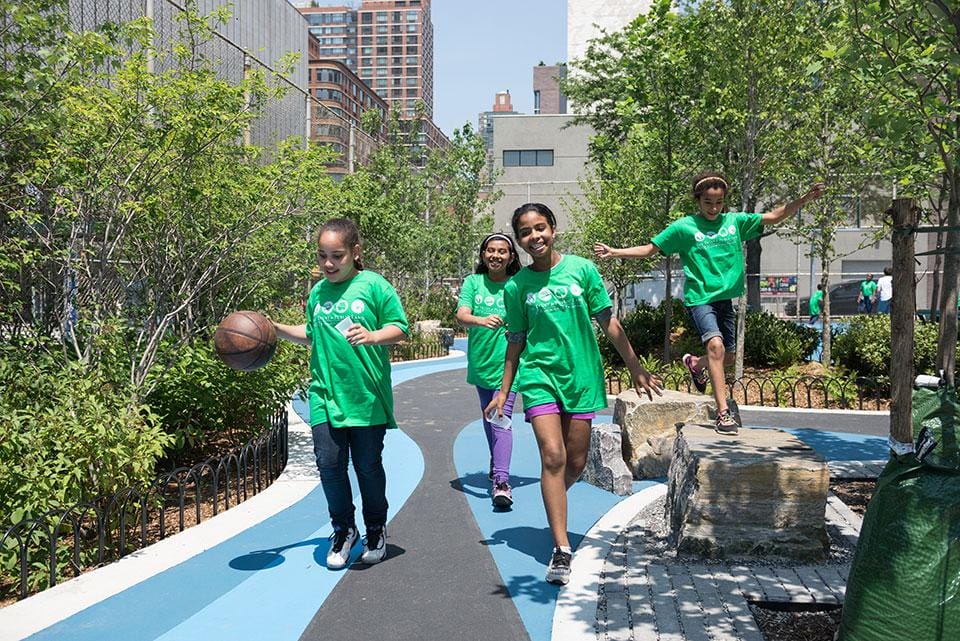
Of the 90,000 public schools in the United States, only a fraction are attractive, healthy, and green—and also open to the public during nonschool hours.
“Every suburban kid knows how much cooler it is under a shade tree,” said McLaughlin, manager of the agency’s Community Collaborative Initiative, which tackles environmental problems like combined sewer overflows, brownfields, illegal dumping, and air pollution. “Every student in Camden should know how much cooler it is under a shade tree. That is not just the right of a suburban kid. That should be a right of every kid.”
A solution for every community
What might come as a surprise is that schools in urban areas are not the only ones that need greening. Children in rural areas can also lack access to adequate play space and even nature. That’s because much of the land outside cities is private, and thus posted with “No Trespassing” signs. Moreover, parks and playgrounds in more spread-out rural areas tend not to be within walking distance.
[Read more: Special report explores the benefits of taking learning outside]
A prime example is in Huntington, Vermont, where a community forest, which The Trust for Public Land helped the town purchase this spring, serves as an extension of the local elementary school. The 245-acre forest, which unfurls next to Brewster-Pierce Memorial School in the Green Mountains, is used by students and teachers for science exploration and nature hikes. Now that the land is publicly owned, the physical education program hopes to create a low-ropes course and a mountain biking trail.
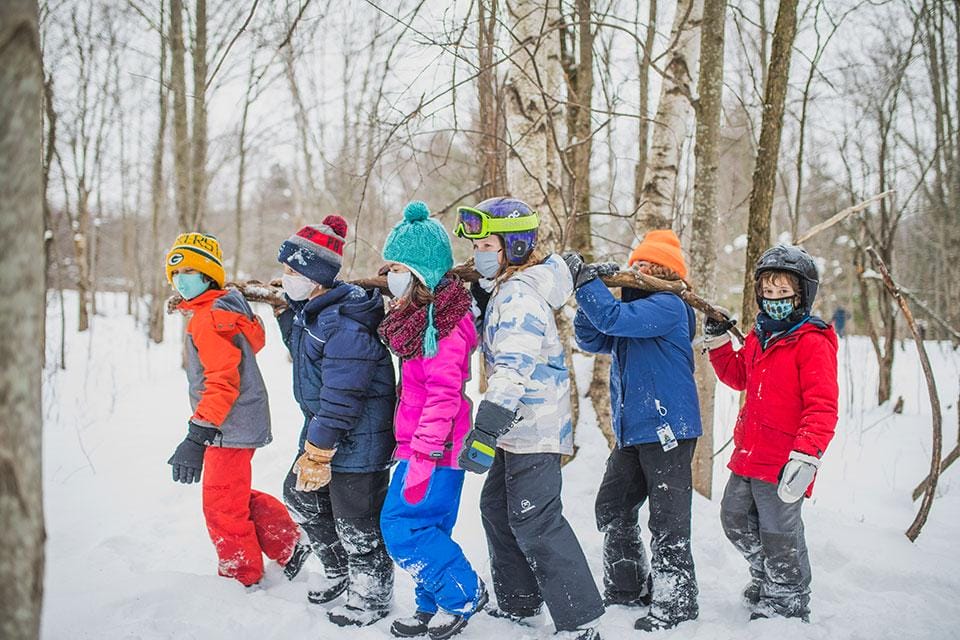
A public elementary school in Huntington, Vermont, is taking advantage of an adjacent forest that the town, with help from The Trust for Public Land, purchased (and forever protected) earlier this year.
On the other side of the United States, in Chiloquin, Oregon, a small rural community four hours south of Portland, students at the elementary school there are providing input for a new Community Schoolyard. Janelle Emard is the vice principal and instructional coach at Chiloquin Elementary School, which serves 180 students in kindergarten through sixth grade. (One hundred percent of students qualify for free lunch.) Emard is adamant that her students deserve access to nature during the school day.
Currently, the schoolyard is an uninviting canvas of dried grass and weeds, with a patch of mostly decades-old play equipment. While the new Community Schoolyard will feature fresh equipment and covered basketball courts (so students can play in rain and snow), the grounds will also boast an outdoor classroom, a pollinator garden, raised beds for vegetables and herbs, and a meadow laced with walking trails.
“We want the kids to have a buy-in to their education,” Emard explains. “They spend a lot of time here and the learning environment should be positive, both inside and out. The more positive the environment, the more they will want to come to school and learn. The traditional classroom fits certain kids. But other students need to be outside with hands-on activities. You need a space for that.”
The park access solution that’s hiding in plain sight
Whether rural or urban, Community Schoolyards projects fill a void by providing new access to parkland. Opening all public schoolyards during nonschool hours would put a park within a 10-minute walk of nearly 20 million people. “That would be a game changer,” said Danielle Denk, who leads the schoolyards initiative at The Trust for Public Land. “Close-to-home green space contributes to healthy, cohesive communities.”
In the Crown Heights section of Brooklyn, a schoolyard that was renovated in 2009 at P.S. 221 turned a blank (asphalt) slate into an emerald-green oasis, with climbing structures, basketball hoops, game tables, a turf field, trees, and a gazebo. The renovation, planned in conjunction with community partners like Friends of Crown Heights, gave the 650 students in kindergarten through fifth grade a new reason to venture outside. It also paid dividends for the community.
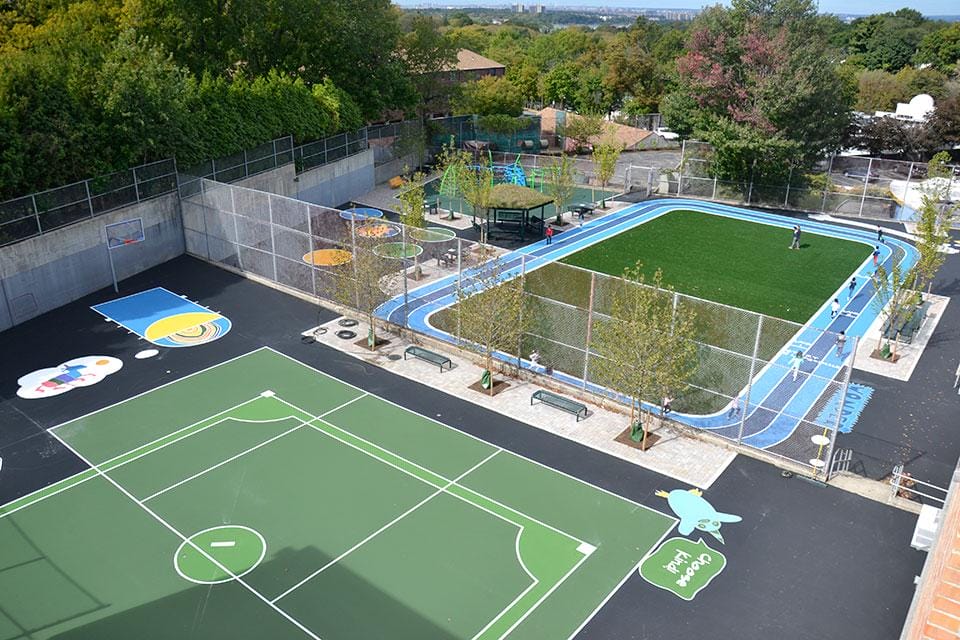
New research from The Trust for Public Land reveals a strong connection between income and schoolyard temperature. Schoolyards that skew hotter are more likely to be surrounded by households on the lower end of the income spectrum.
Adele Sirota, a mother of six who lives in an apartment near the school, was there recently on a humid, overcast day with her two daughters, ages four and two. She has lived next to the school for 15 years and remembers when the schoolyard was renovated a dozen years ago. Her older children attend a nearby yeshiva, but thanks to a shared-use agreement between the school and the city’s parks department, the schoolyard functions as a neighborhood park during nonschool hours. As a result, each of Sirota’s children has spent many happy hours in the green space.
“We absolutely love it,” she said while her daughters traipsed across the schoolyard. “It’s a savior for us. My little ones can do everything except the monkey bars. Those are still a little high. Our 10-year-old likes to bring his bike and ride around the track.”
More and more cities are deciding to make schoolyards available to the public after school and on weekends. In The Trust for Public Land’s most recent ParkScore® index25, an annual ranking of park systems in the 100 largest U.S. cities, the survey of parks officials revealed a noticeable uptick in joint-use agreements. This year, 58 of 100 cities reported having such an agreement in place, an increase of 30 percent since 2018.
Ronda Chapman, The Trust for Public Land’s equity director, says joint-use agreements with public schools are an effective way to expand park access, thanks to their ubiquity. “The reality is that all across the U.S., we have the potential to create nurturing, safe, and active schoolyards in every community,” Chapman said. “Those schoolyards can positively impact and connect not only school-aged youth, but their families and neighbors alike.”

To bring the Community Schoolyards model to every town and city will require an all-hands-on-deck approach. Congress needs to increase federal funding so that every child can go out and play on a schoolyard that is both vibrant and healthy.
Community Schoolyards projects are a “right now” fix for the park equity gap
Transforming schoolyards into shared public parks is a common-sense, cost-effective solution to America’s park-equity problem. To date, The Trust for Public Land has renovated nearly 300 schoolyards nationwide. Extending these benefits to every schoolyard would solve the problem of outdoor access for one-fifth of the nation’s 100 million people who don’t currently have a park close to home and would make an immediate difference in the health, equity, and climate resilience of communities nationwide.
But public schools need the resources to make the critical changes embodied by the Community Schoolyards model. Even before the pandemic, persistent underfunding of the nation’s schools had led to deteriorated conditions, and students and educators have been forced to learn and work in outdated, sometimes hazardous buildings.
[We’re bringing more parks to communities across the country. Sign up for the latest news about this important work.]
To bring schoolyards to scale in a way that meaningfully improves the lives of public school students, we must mobilize funding from a variety of sources, both public and private.
Congress needs to increase federal funding for Community Schoolyards initiatives. And at the state and local levels, school districts should tap money available under the recently enacted American Rescue Plan, which set aside money to help them reopen amid the pandemic. School administrators can also partner with local environmental protection agencies, many of which have funding for green infrastructure in order to improve water quality. There is a role, too, for nonprofits, foundations, and corporations to help make inspired, nature-filled schoolyards the norm in every community in America.
Together, we can address the unhealthy—indeed, dangerous—state of the nation’s schoolyards so that students have access to opportunities for recreation, outdoor learning, and physical activity, setting them up for a lifetime of success.

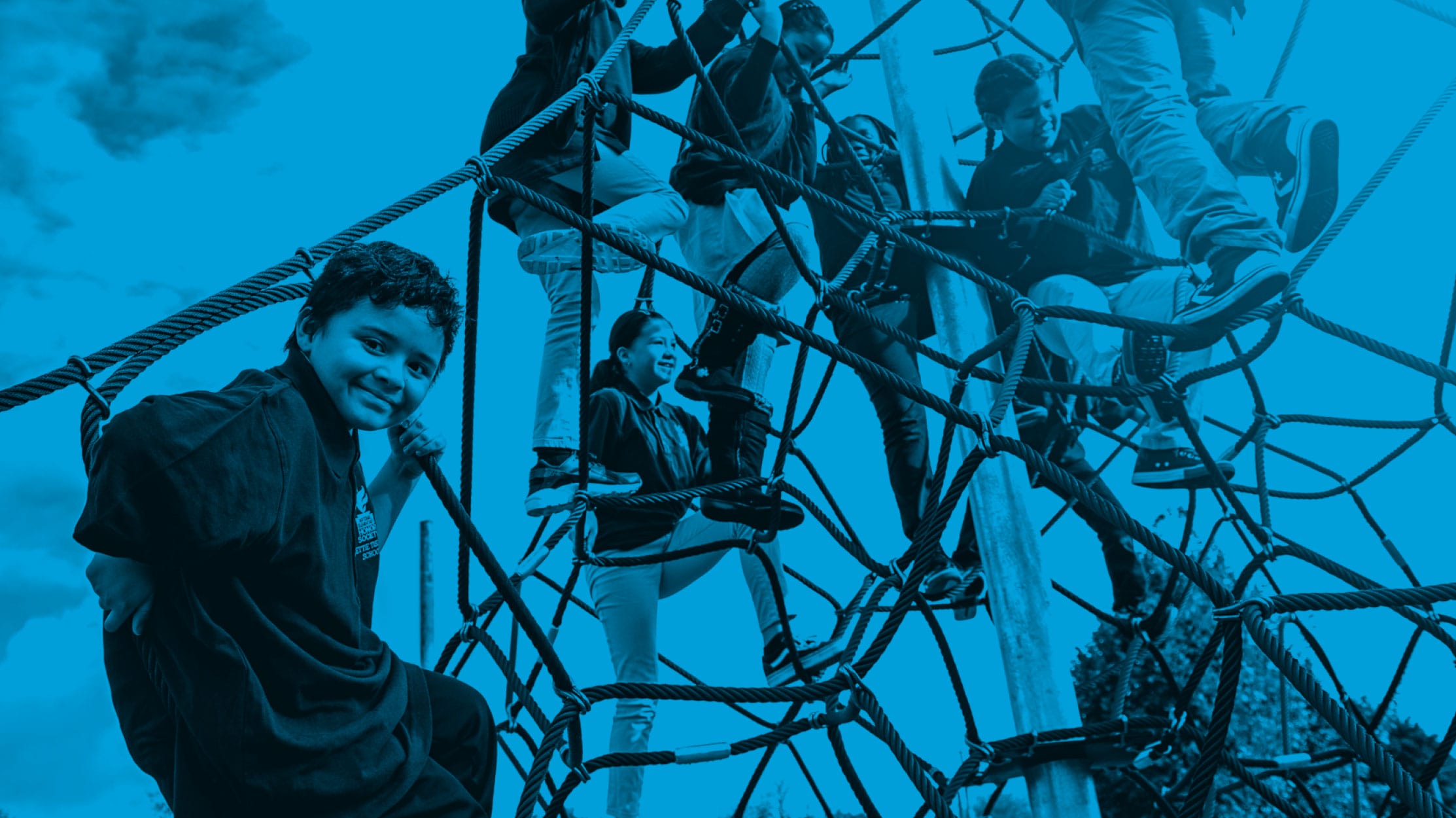
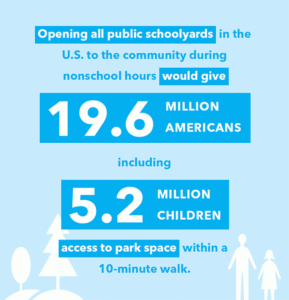 The schoolyard solution
The schoolyard solution